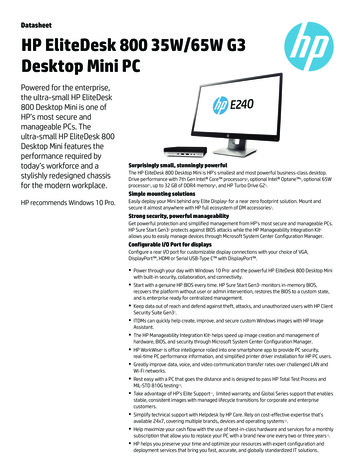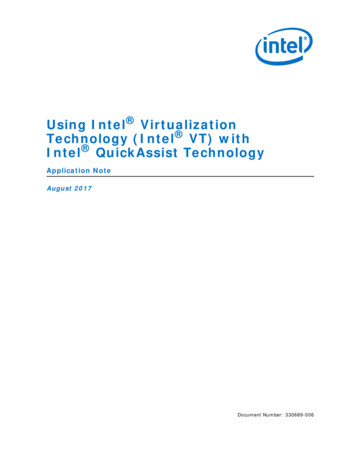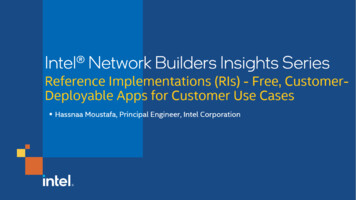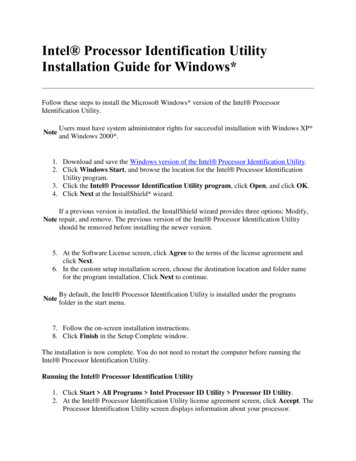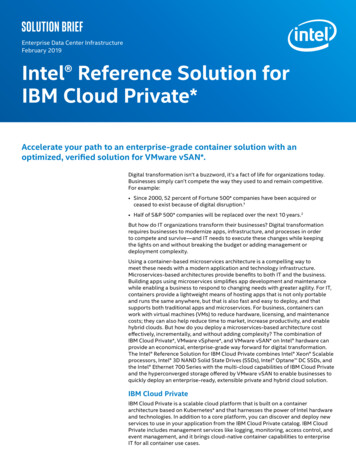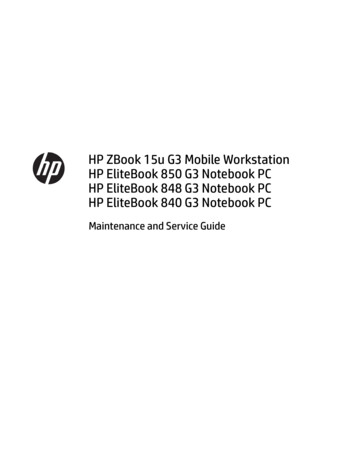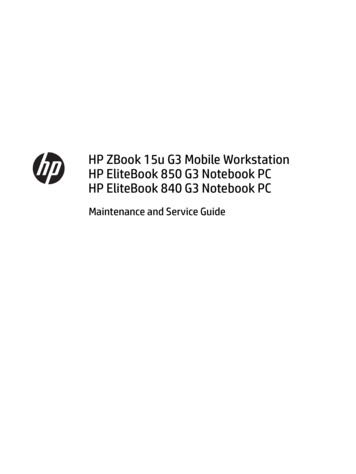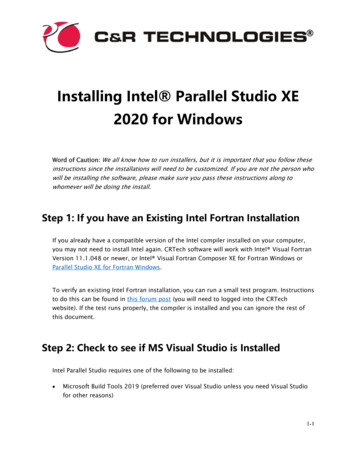
Transcription
Assembly Language for Intel-BasedComputers, 4th EditionKip R. IrvineChapter 5: ProceduresLecture 18 Linking to External LibraryThe Book’s Link LibraryStack OperationsSlides prepared by Kip R. IrvineRevision date: 08/22/2002Modified by Dr. Nikolay Metodiev SirakovOctober 25, 2009 Chapter corrections (Web) Assembly language sources (Web)(c) Pearson Education, 2002. All rights reserved. You may modify and copy this slide show for your personal use, or foruse in the classroom, as long as this copyright statement, the author's name, and the title are not changed.
The Book's Link Library Link Library OverviewCalling a Library ProcedureLinking to a LibraryLibrary Procedures – OverviewSix ExamplesMarch 28.2005, 3PM-4:15PMIrvine, KipR. Assembly Language for Intel-Based Computers, 2003.Web siteExamples2
Link Library Overview A file containing procedures that have been compiledinto machine code constructed from one or more OBJ files To build a library, . . . start with one or more ASM source filesassemble each into an OBJ filecreate an empty library file (extension .LIB)add the OBJ file(s) to the library file, using theMicrosoft LIB utilityTake a quick look at Irvine32.asm by clicking on Examples at the bottomof this screen.March 28.2005, 3PM-4:15PMIrvine, KipR. Assembly Language for Intel-Based Computers, 2003.Web siteExamples3
Calling a Library Procedure Call a library procedure using the CALL instruction. Someprocedures require input arguments. The INCLUDE directivecopies in the procedure prototypes (declarations). The following example displays "1234" on the console:INCLUDE Irvine32.inc.codemov eax,1234hcall WriteHexcall CrlfMarch 28.2005, 3PM-4:15PMIrvine, KipR. Assembly Language for Intel-Based Computers, 2003.; input argument; show hex number; end of lineWeb siteExamples4
Linking to a Library Your programs link to Irvine32.lib using the linker commandinside a batch file named make32.bat. Notice the two LIB files: Irvine32.lib, and kernel32.lib the latter is part of the Microsoft Win32 SoftwareDevlopment KitYour programlinkstoIrvine32.liblinks tocan link tokernel32.libexecuteskernel32.dllMarch 28.2005, 3PM-4:15PMIrvine, KipR. Assembly Language for Intel-Based Computers, 2003.Web siteExamples5
Library Procedures - Overview (1 of 3)Clrscr - Clears the console and locates the cursor at the upper leftcorner.Crlf - Writes an end of line sequence to standard output.Delay - Pauses the program execution for a specified nmillisecond interval.DumpMem - Writes a block of memory to standard output inhexadecimal.DumpRegs - Displays the EAX, EBX, ECX, EDX, ESI, EDI, EBP,ESP, EFLAGS, and EIP registers in hexadecimal. Also displaysthe Carry, Sign, Zero, and Overflow flags.GetCommandtail - Copies the program’s command-linearguments (called the command tail) into an array of bytes.GetMseconds - Returns the number of milliseconds that haveelapsed since midnight.March 28.2005, 3PM-4:15PMIrvine, KipR. Assembly Language for Intel-Based Computers, 2003.Web siteExamples6
Library Procedures - Overview (2 of 3)Gotoxy - Locates cursor at row and column on the console.Random32 - Generates a 32-bit pseudorandom integer in therange 0 to FFFFFFFFh.Randomize - Seeds the random number generator.RandomRange - Generates a pseudorandom integer within aspecified range.ReadChar - Reads a single character from standard input.ReadHex - Reads a 32-bit hexadecimal integer from standardinput, terminated by the Enter key.ReadInt - Reads a 32-bit signed decimal integer from standardinput, terminated by the Enter key.ReadString - Reads a string from standard input, terminated bythe Enter key.March 28.2005, 3PM-4:15PMIrvine, KipR. Assembly Language for Intel-Based Computers, 2003.Web siteExamples7
Library Procedures - Overview (3 of 3)SetTextColor - Sets the foreground and background colors of allsubsequent text output to the console.WaitMsg - Displays message, waits for Enter key to be pressed.WriteBin - Writes an unsigned 32-bit integer to standard output inASCII binary format.WriteChar - Writes a single character to standard output.WriteDec - Writes an unsigned 32-bit integer to standard output indecimal format.WriteHex - Writes an unsigned 32-bit integer to standard output inhexadecimal format.WriteInt - Writes a signed 32-bit integer to standard output indecimal format.WriteString - Writes a null-terminated string to standard output.March 28.2005, 3PM-4:15PMIrvine, KipR. Assembly Language for Intel-Based Computers, 2003.Web siteExamples8
Example 1Clear the screen, delay the program for 500 milliseconds, anddump the registers and flags.codecall Clrscrmov eax,500call Delaycall DumpRegsSample output:EAX 00000613 EBX 00000000 ECX 000000FF EDX 00000000ESI 00000000 EDI 00000100 EBP 0000091E ESP 000000F6EIP 00401026 EFL 00000286 CF 0 SF 1 ZF 0 OF 0March 28.2005, 3PM-4:15PMIrvine, KipR. Assembly Language for Intel-Based Computers, 2003.Web siteExamples9
Example 2Display a null-terminated string and move the cursor to thebeginning of the next screen line.datastr1 BYTE "Assembly language is easy!",0.codemov edx,OFFSET str1call WriteStringcall CrlfMarch 28.2005, 3PM-4:15PMIrvine, KipR. Assembly Language for Intel-Based Computers, 2003.Web siteExamples10
Example 3Display the same unsigned integer in binary, decimal, andhexadecimal. Each number is displayed on a separate line.IntVal 35.codemov eax,IntValcall WriteBincall Crlfcall WriteDeccall Crlfcall WriteHexcall Crlf; constant; display binary; display decimal; display hexadecimalSample output:0000 0000 0000 0000 0000 0000 0010 00113523March 28.2005, 3PM-4:15PMIrvine, KipR. Assembly Language for Intel-Based Computers, 2003.Web siteExamples11
Example 4Input a string from the user. EDX points to the memory areawhere the string will be stored and ECX specifies the maximumnumber of characters the user is permitted to enter 1.datafileName BYTE 80 DUP(0).codemov edx,OFFSET fileNamemov ecx,SIZEOF fileNamecall ReadStringMarch 28.2005, 3PM-4:15PMIrvine, KipR. Assembly Language for Intel-Based Computers, 2003.Web siteExamples12
Example 5Generate and display ten pseudorandom signed integers in therange 0 – 99. Each integer is passed to WriteInt in EAX anddisplayed on a separate line.codemov ecx,10; loop counterL1: CrlfL1March 28.2005, 3PM-4:15PMIrvine, KipR. Assembly Language for Intel-Based Computers, 2003.ceiling valuegenerate random intdisplay signed intgoto next display linerepeat loopWeb siteExamples13
Example 6Display a null-terminated string with yellow characters on a bluebackground.datastr1 BYTE "Color output is easy!",0.codemovcallmovcallcalleax,yellow (blue * 16)SetTextColoredx,OFFSET str1WriteStringCrlfThe background color must be multiplied by 16 before you add it tothe foreground color.March 28.2005, 3PM-4:15PMIrvine, KipR. Assembly Language for Intel-Based Computers, 2003.Web siteExamples14
Stack Operations Runtime StackPUSH OperationPOP OperationPUSH and POP InstructionsUsing PUSH and POPExample: Reversing a StringRelated InstructionsMarch 28.2005, 3PM-4:15PMIrvine, KipR. Assembly Language for Intel-Based Computers, 2003.Web siteExamples15
Runtime Stack Managed by the CPU, using two registers SS (stack segment) ESP (stack pointer) 00000FF0* SP in Real-address modeMarch 28.2005, 3PM-4:15PMIrvine, KipR. Assembly Language for Intel-Based Computers, 2003.Web siteExamples16
PUSH Operation (1 of 2) A 32-bit push operation decrements the stack pointerby 4 and copies a value into the location pointed toby the stack 0000FF00000100000000006ESPMarch 28.2005, 3PM-4:15PMIrvine, KipR. Assembly Language for Intel-Based Computers, 2003.Web siteExamplesESP17
PUSH Operation (2 of 2) This is the same stack, after pushing two more 00FF80000000100000FF400000002ESP00000FF0The stack grows downward. The area below ESP is alwaysavailable (unless the stack has overflowed).March 28.2005, 3PM-4:15PMIrvine, KipR. Assembly Language for Intel-Based Computers, 2003.Web siteExamples18
POP Operation Copies value at stack[ESP] into a register or variable. Adds n to ESP, where n is either 2 or 4. depends on the attribute of the operand receiving 000FF80000000100000FF400000002ESP00000FF0March 28.2005, 3PM-4:15PMIrvine, KipR. Assembly Language for Intel-Based Computers, 2003.ESP00000FF400000FF0Web siteExamples19
PUSH and POP Instructions PUSH syntax: PUSH r/m16 PUSH r/m32 PUSH imm32 POP syntax: POP r/m16 POP r/m32March 28.2005, 3PM-4:15PMIrvine, KipR. Assembly Language for Intel-Based Computers, 2003.Web siteExamples20
Using PUSH and POPSave and restore registers when they contain important values.Note that the PUSH and POP instructions are in the oppositeorder:push esipush ecxpush ebx; push registersmov esi,OFFSET dwordValmov ecx,LENGTHOF dwordValmov ebx,TYPE dwordValcall DumpMem;;;;pop ebxpop ecxpop esi; opposite orderMarch 28.2005, 3PM-4:15PMIrvine, KipR. Assembly Language for Intel-Based Computers, 2003.starting OFFSETnumber of unitssize of a doubleworddisplay memoryWeb siteExamples21
Example: Nested LoopRemember the nested loop we created on page 129? It's easyto push the outer loop counter before entering the inner loop:mov ecx,100L1:push ecxmov ecx,20L2:; set outer loop count; begin the outer loop; save outer loop count; set inner loop count; begin the inner loop;;loop L2; repeat the inner looppop ecxloop L1; restore outer loop count; repeat the outer loopMarch 28.2005, 3PM-4:15PMIrvine, KipR. Assembly Language for Intel-Based Computers, 2003.Web siteExamples22
Example: Reversing a String Use a loop with indexed addressing Push each character on the stack Start at the beginning of the string, pop the stack in reverseorder, insert each character into the string Source code Q: Why must each character be put in EAX before it is pushed?Because only word (16-bit) or doubleword (32-bit) valuescan be pushed on the stack.March 28.2005, 3PM-4:15PMIrvine, KipR. Assembly Language for Intel-Based Computers, 2003.Web siteExamples23
Your turn . . . Using the String Reverse program as a startingpoint, #1: Modify the program so the user can input a string of up to50 characters. #2: Modify the program so it inputs a list of 32-bit integersfrom the user, and then displays the integers in reverseorder.March 28.2005, 3PM-4:15PMIrvine, KipR. Assembly Language for Intel-Based Computers, 2003.Web siteExamples24
Related Instructions PUSHFD and POPFD push and pop the EFLAGS register PUSHAD pushes the 32-bit general-purposeregisters on the stack order: EAX, ECX, EDX, EBX, ESP, EBP, ESI, EDI POPAD pops the same registers off the stack inreverse order PUSHA and POPA do the same for 16-bit registersMarch 28.2005, 3PM-4:15PMIrvine, KipR. Assembly Language for Intel-Based Computers, 2003.Web siteExamples25
Your Turn . . . Write a program that does the following: Assigns integer values to EAX, EBX, ECX, EDX, ESI,and EDI Uses PUSHAD to push the general-purpose registerson the stack Using a loop, the program pops each integer from thestack and displays it on the screenMarch 28.2005, 3PM-4:15PMIrvine, KipR. Assembly Language for Intel-Based Computers, 2003.Web siteExamples26
March 28.2005, 3PM-4:15PM Irvine, Kip Web site Examples R. Assembly Language for Intel-Based Computers, 2003. 2 The Book's Link Library Link Library Overview Calling a Library Procedure Linking to a Library Library Procedures - Overview . Microsoft LIB utility Take a quick look at Irvine32.asm by clicking on Examples at the bottom

